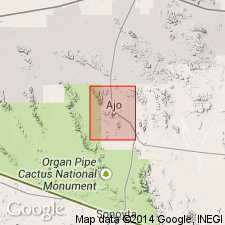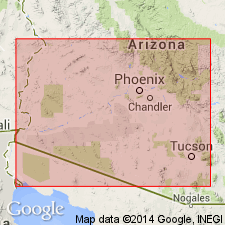
- Usage in publication:
-
- Batamote andesite*
- Modifications:
-
- Original reference
- Dominant lithology:
-
- Andesite
- AAPG geologic province:
-
- Basin-and-Range province
Summary:
Pg. 48-49, pl. 1. Batamote andesite. Comprises three principal varieties of basaltic andesite flows: dense dark-gray rock that weathers reddish brown with small rare crystals of hornblende and feldspar; platy dark-gray brown-weathering, generally more or less vesicular, finely porphyritic rock; and the most widespread variety, medium-gray, generally massive though locally platy, aphanitic olivine andesite, which forms bulk of Black, Batamote, and Childs Mountains. Some flows may be true basalts. At Black Mountain, basaltic andesite consists of dark flow breccias and massive flows that range in thickness from about 20 to 60 feet and average about 30 feet. Full thickness 1,348 feet. Unconformably overlies Childs augite latite (new) in Batamote and Childs Mountains and the Cardigan gneiss and conglomerate elsewhere. Age is Pliocene(?).
Named from Batamote Mountains, the bulk of which are made up of the andesite. Most widespread of the bedrock formations in Ajo quadrangle.
[Batamote Mountains, Lat. 32 deg. 28 min. N., Long. 112 deg. 45 min. W., Ajo quadrangle, Pima Co., central southern AZ.]
Source: US geologic names lexicon (USGS Bull. 1200, p. 234-235).

- Usage in publication:
-
- Batamote Andesite
- Modifications:
-
- Geochronologic dating
- AAPG geologic province:
-
- Basin-and-Range province
Summary:
Basalt in Batamote Andesite has a radiometric age K-Ar of 15 +/-2.2 m.y. or Miocene age. [This is an assignment change from Pliocene?] Sampled locality is in Pima Co, AZ in the Basin-and-Range province.
Source: GNU records (USGS DDS-6; Denver GNULEX).
For more information, please contact Nancy Stamm, Geologic Names Committee Secretary.
Asterisk (*) indicates published by U.S. Geological Survey authors.
"No current usage" (†) implies that a name has been abandoned or has fallen into disuse. Former usage and, if known, replacement name given in parentheses ( ).
Slash (/) indicates name conflicts with nomenclatural guidelines (CSN, 1933; ACSN, 1961, 1970; NACSN, 1983, 2005, 2021). May be explained within brackets ([ ]).

